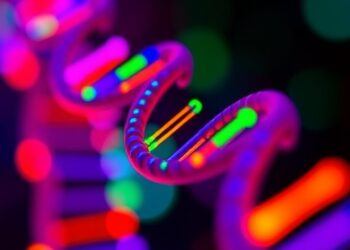Research from Stanford University has revealed a new perspective on the origin of life on Earth, proposing that the complex organic molecules vital for life may have emerged not from dramatic lightning strikes, but from the more subtle interactions of tiny water droplets. This groundbreaking research suggests that the energetic processes involved in water microdroplets might have provided the necessary conditions for the formation of fundamental organic compounds, particularly during the early epochs of Earth’s history when life first began to take shape.
The team, led by renowned chemist Richard Zare, suggests that these small-scale electrical discharges, akin to "microlightning," occur naturally when water droplets collide and separate. Their research replicates conditions believed to be prevalent in Earth’s primordial atmosphere, using simple water sprays in conjunction with a mix of gases thought to have existed in that ancient time. This innovative approach contrasts with the famed Miller-Urey experiment of 1952, which demonstrated that organic compounds could arise from simulated lightning in a laboratory setting.
The Miller-Urey hypothesis has traditionally anchored theories about life’s origins; however, it has come under scrutiny. Critics argue that the occurrences of lightning strikes would have been too sparse to spark the extensive chemical evolution necessary for life. By focusing instead on the frequent energy generation from microlightning, this research offers a compelling alternative that may better match our understanding of environmental chemistry on early Earth.
In their experiments, Zare and his colleagues carefully studied the behavior of water droplets as they formed and broke apart. They discovered a remarkable phenomenon: when larger droplets collided with smaller ones, they developed opposing electrical charges. The charges accumulated until microelectrical discharges erupted, releasing energy that catalyzed chemical reactions in a surrounding gas mixture comprising nitrogen and other essential gases like methane and ammonia.
The results were striking. The researchers identified the formation of hydrogen cyanide, a precursor to amino acids, and uracil, a crucial component of RNA. These findings illuminate the potential pathways through which life’s building blocks could have originated, suggesting that water sprays—common features of many natural environments—were instrumental in assembling the complex chemistry required for life, rather than relying solely on the dramatic events of lightning strikes.
Understanding how these minute discharges can lead to significant chemical reactions could transform our comprehension of prebiotic chemistry. This insight offers solutions to long-standing questions regarding how organic molecules, essential for life, could form in a world teeming with inorganic compounds yet lacking complex biological entities. By examining microlightning instead of full-blown lightning storms, researchers create a more plausible narrative of life’s origins based on the ubiquity of water in early environments.
This new research offers a fresh, enlightening lens on the age-old mystery of how life could arise from non-life. By substantiating the hypothesis of microlightning-induced chemical reactions, Zare’s team not only advances the discussion surrounding the origins of life, but also challenges preconceived notions about the environmental conditions required for the synthesis of vital organic molecules.
The potential for microlightning to drive complex biochemical pathways opens fascinating avenues for future studies. Delving into the myriad interactions of microscopic water droplets could unveil new aspects of organic chemistry and its applications, extending beyond historical inquiries into life’s beginnings. This research advocates for a broader consideration of water’s role as a reactive and potent agent in various chemical processes, emphasizing its significance in prebiotic chemistry.
As the dialogue surrounding the origins of life progresses, the implications of this research convey a profound message. Water, often perceived as a benign and simple compound, is portrayed as a dynamic participant in chemical evolution. Exploring this nuanced perspective invites scientists to rethink the properties of water and its integral role not only in sustaining life but also in igniting the very chemistry that facilitated life’s emergence.
The findings prompt various interdisciplinary discussions, bridging chemistry, biology, and earth sciences. They underscore the importance of collaborative efforts in unravelling fundamental questions concerning life on Earth. As researchers revisit earlier hypotheses with newfound data and perspectives, the path toward understanding life’s origins becomes ever more expansive, and deeply intriguing.
In conclusion, the revelations emerging from Stanford University provide an innovative approach to an enduring enigma: how did life begin? The exploration of microlightning as a central mechanism for organic molecule formation offers a promising direction that encourages ongoing research into the chemistry of life. This scientific inquiry not only seeks answers to a fundamental question but also inspires a re-examination of the elements essential for life itself, reshaping our understanding of the universe’s intricate tapestry.
Ultimately, Zare’s investigation not only provides a clearer picture of life’s beginnings but also highlights the hidden complexities of common substances. Water, with its powerful capabilities when divided into microdroplets, serves as a reminder of the uncharted domains of scientific discovery. This study emphasizes that to unlock the mysteries of life, we need to examine the ordinary and frequently overlooked aspects of the world around us.
Subject of Research: The origin of life and the role of water microdroplets in the formation of organic molecules.
Article Title: Spraying of Water Microdroplets Forms Luminescence and Causes Chemical Reactions in Surrounding Gas.
News Publication Date: 14-Mar-2025.
Web References: DOI Link
References: Citation from the journal Science Advances.
Image Credits: Not specified.
Keywords
Water chemistry, Organic compounds, Chemical bonding, Prebiotic chemistry, Nitrogen compounds, Microlightning, Early Earth conditions.




